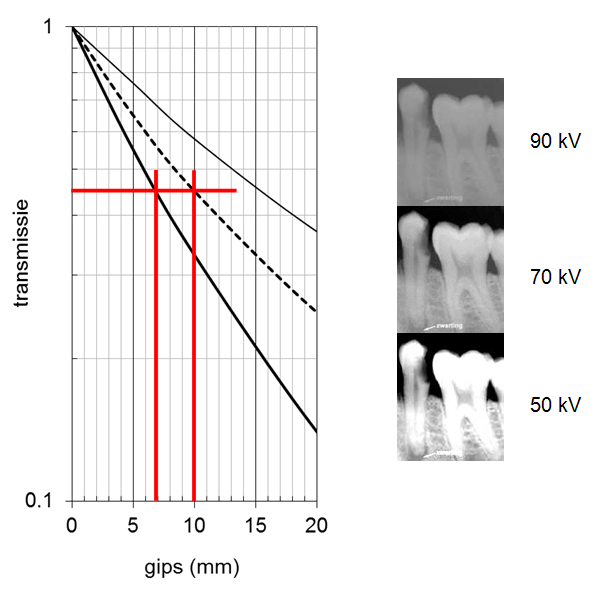Contrast and tube voltage

The Figure above shows the transmission of X-radiation through gypsum (= plaster) for tube voltages of 50 kV, 70 kV and 90 kV. Gypsum is calcium sulphate, a substance that is chemically closely related to calcium phosphate, the main constituent of bone and enamel. The bitewing recording is of a hypothetical molar tooth of plaster with a diameter of 10 mm. It can be seen that 70 kV is the optimum tube voltage. With a tube voltage of 90 kV, the contrast is insufficient, and with a tube voltage of 50 kV, on the other hand, it is too large.
Contrast depends on the difference between the maximum and the minimum density in an X-ray image. The maximum blackening occurs where the thickness of the displayed object is 0 and therefore the transmission is 1. The minimum blackening is obtained where the object has its maximum thickness: in this case it is 10 mm, for which the transmission is 0.45 (see Figure, middle curve).
For a ten year old child all dimensions, including the sizes of teeth and molars, are smaller by about 30% as compared to adults: the maximum thickness of our object is, therefore, not 10 mm but only 7 mm. In order to obtain a good image, the tube voltage must be chosen such that the transmission has the optimal value of 0.45 at a thickness of 7 mm. A tube voltage of 50 kV will fulfill this requirement (see Figure, bottom curve).
For an optimal image, therefore, one should opt for a smaller tube voltage when examining children. Using his expertise, the dentist should know what the best tube voltage is in a particular case.
| Last modified: | 12 November 2020 12.35 p.m. |
